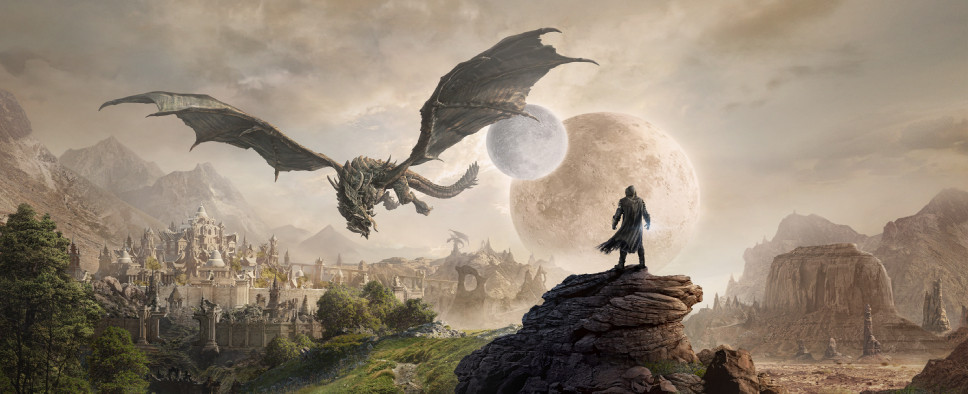The Elder Scrolls Online: Elsweyr - Become the Necromancer Trailer and Class Overview
-
Category: News ArchiveHits: 1496

The upcoming Elsweyr expansion for Bethesda's MMORPG The Elder Scrolls Online will let us play as Necromancers when it launches on June 4, 2019. And if you'd like to see a short preview of the grim new class and its impressive capabilities, you should watch this “Become the Necromancer” trailer:
And then, you may be interested in reading this article on the game's website that talks a bit about Tamriel's Necromancers and their outlaw status. More on that:
NECROMANCERS IN TAMRIEL
Throughout the Elder Scrolls series, Tamriel has a long, often troubled history with necromancy, and this is especially true during the period of The Elder Scrolls Online. It’s no secret that Mannimarco is a powerful necromancer, and with the help of his Daedric patron Molag Bal, he controls Cyrodiil with armies of both Daedra and the undead.
But what is necromancy in the Elder Scrolls and The Elder Scrolls Online? A lot remains unknown about Tamriel’s dark arts, and no shortage of debate and controversy surrounds its practice.
“In broad strokes, necromancy is about the creative manipulation of the soul, or animus, which is one of the basic building blocks of life in Tamriel,” explains Leamon Tuttle, ESO’s Loremaster. “Necromancers use their power to cast spells, bind souls into service, and use lesser Daedric spirits to reanimate corpses.”
When discussing necromancy, it’s important to note that even its definition is a point of contention.
“The Mages Guild identifies necromancy as its own distinct school of magic, but some Necromancers say it’s just an offshoot of mysticism, conjuration, and enchantment—no more dangerous than fireballs and scrying spells.”
However you choose to define it, necromancy has existed in Tamriel for a long time before the events of ESO, but despite its long history, the practice of necromancy is, broadly speaking, forbidden.
“The practice is frowned upon in most cultures, but some people such as the Redguards and Dark Elves see it as the ultimate blasphemy,” explains Tuttle. “To them, messing with their ancestors is a huge no-no, and organizations like the Mages Guild reject it on ethical grounds, since it involves messing with mortal souls.”
In The Elder Scrolls Online, the practice of necromancy allows you to master frightful new powers, but, given its reputation, it also brings new challenges, too.
PRACTICED IN SECRET
If you’re set on mastering the dark arts in ESO, you’ll discover that playing a Necromancer requires a certain level of subtlety not found in the game’s other classes. When designing the Necromancer class, the team wanted the choice to be meaningful for reasons other than its three new Skill Lines, and this meant tying the class into the game’s Justice system, bringing consequences for Tamriel’s would-be liches.
“We felt it was important to intertwine necromancy and Justice for much the same reason we put Justice in the game in the first place,” says Ed Stark, the team’s Lead Content Designer in charge of the Necromancer class and the Justice system. “Historically, necromancy has always been frowned-upon by Tamrielic society, and so, when some NPCs see an overtly necromantic act, they react with fear or aggression and report it for the crime it is.”
What does this mean for you if you want to play a Necromancer? In short: If you use some (note, not all) of the Necromancer’s abilities in view of the game’s NPCs, there might be repercussions.
“It’s only things that we consider to be very obvious necromantic actions,” explains Kyle Nowak, the combat designer behind the Necromancer class. “There are abilities that are borderline, like Render Flesh, but raising bodies out of the ground is glaringly obvious and will get you in trouble.”
The Render Flesh healing ability might appear gross, but the people of Tamriel seem to be mostly OK with it. Should you transform yourself into a giant bone colossus right in the middle of town, however, there’s a good chance the local guards are going to notice!
“A player who chooses to assume the role of a necromancer in ESO needs to understand that they’re playing something of an outlaw class,” says Stark. “It’s similar to a player who decided to engage in wholesale crime—they’re taking on a bit of an increased risk in exchange for increased excitement.”
All that said, when designing the Necromancer class’ tie-ins to the Justice system, the team designed the experience to be both immersive and fun, ensuring that you’re not hunted down or penalized simply for playing.
“We put some safeguards in place,” says Nowak. “For example, if you cast something and 10 people witness you, you won’t get 10 times the bounty. We also had to perform an audit on a lot of older content, because there are NPCs within places like delves or quests who can witness Justice actions, and you don’t want to earn a bounty for doing a quest.”

